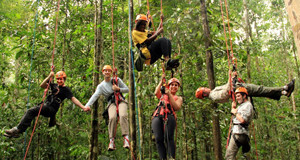
I’m sure you’ve heard the term “Identity Crisis” before. It’s thought of as a conflict of self and society and its introduction came from one of the most famous psychoanalyst of the 20th century.
Sigmund Freud is probably the most familiar name that comes to mind when one thinks of famous psychologists. His basic foundation theories of instinct, phallic symbol obsession and oedipal complexes are prevalent in almost every artistic aspect of our culture. However, it was a friend and fellow psychoanalyst of Freud’s, Erik Erickson, who created one of the major theories that open a window to the development of everything that makes us who we are on the inside. It is referred to as Erickson’s Theory of Human Development and it simplifies the complex topic of human personality.
First, let’s talk about the man himself. Erik Homberger was born in Frankfurt, Germany in 1902. The conditions under which he began life give a great deal of insight into his obsession with identity. He was challenged with it from the stat. His parents weren’t married and his Danish father left before Erik was born. His Jewish mother married Erik’s pediatrician when he was three. Erik had Nordic features; he was tall, blond and had blue eyes. Neither the Jewish children at temple nor the German children at school accepted him.
As he grew up, psychology and art began to interest Erik and led him to various institutes including one where he was psychoanalyzed by Anna Freud, wife of Sigmund. Both later became close friends to Erickson. When the Nazis came to power, Erik moved to Boston where he studied child psychoanalysis and was influenced by many psychologists and anthropologists Mead, but many famous psychologists and anthropologists.
He is considered a Freudian ego-psychologist, meaning he takes the basic foundation of Freud’s theories, but veers away by focus on social and cultural orientation. Erickson’s theory closely ties personality growth with parental and societal values. His 1950 book, Childhood and Society, is considered a classic in its field.
There are eight stages of human development, each focusing on a different conflict that we need to solve in order to development successfully into the next stage of our lives. The idea is that if we don’t resolve each stage or we choose the wrong of two choices, our ability to deal with the consecutive stages is impaired and the failure will return to us at some point later in life.
Stage One: Oral Sensory
Ages: Birth To 12-18 Months
Conflict: Trust vs Mistrust
The infant’s bond with their primary caregiver is about trust and love. The connection with that person (usually Mommy) allows them to feel like they are safe and can rely on the person who is basically the only thing they know. It’s about touch and being there and can be seen in that tender stare they give you as you feed them.
Stage Two: Muscular Anal
Ages: 18 Months To 3 Years
Conflict: Autonomy vs Doubt
This stage focuses on self control and self confidence and Erickson gives toilet training as the greatest example of this conflict. He also points out that this is the stage where an overprotective parent can do the most damage. The child wants autonomy. We’re all familiar with the two hour wait because they have to tie their own shoes. We wait because in this stage, failure to reinforce these efforts will lead the child to doubt themselves and your trust in them.
Stage Three: Locomotor
Ages: 3 To 6 Years
Conflict: Initiative vs Guilt
This is all about independence and letting the child exert his/her initiative. This is the stage where carrying your car keys or helping Mommy in any way possible is very important. They are developing a sense of responsibility and limitations. They will try to do things they can’t and the response the parent gives them, encouragement or refusal, will allow the child to understand limitations without guilt.
Stage Four: Latency
Ages: 6 To 12 Years
Conflict: Industry vs Inferiority
This is about completion. Before this stage, we’re all familiar with the child beginning to do something, but then snap; he drops it and is on to something else. In this stage, completion and the pleasure it brings becomes crucial. This is greatly influenced by their introduction to school beyond day care. It is the coming together of mental and physical capabilities as well. Parents need to encourage their child to handle the different experiences of a home atmosphere and the atmosphere at school among others.
Stage Five: Adolescence
Ages: 12 To 18 Years
Conflict: Identity vs Role Confusion
This stage could be a book in itself; the teenage years. They are hard on everyone, but especially the child herself. They are aware that they will become a contributor to society (industry) and the search for who they are drives their actions and thoughts. The desire to know what it is they want and believe separate from what they’ve adopted from their parents is crucial to their self confidence.
Stage Six: Young Adulthood
Ages: 19 To 40 Years
Conflict: Psychosocial Development
Love relationships dominate this stage for all of us and relies heavily on our ability to solve the conflicts faced in stage five. Can you be intimate? Can you be open? Can you commit? Intimacy is referred to as the ability to make a personal commitment and doesn’t necessarily mean sex. Personal commitment, met with mutual satisfaction, make this a successful stage. If unable to handle this stage, an adult will resort to isolation.
Stage Seven: Middle Adulthood
Ages: 40 To 65 Years
Conflict: Generativity vs Stagnation
The words are getting bigger, but stay with me. Generativity is our ability to care for someone else which is mostly displayed in parenting. Specifically, it’s the ability to direct someone into society and the next generation. We don’t focus on death, but we begin to understand that we are high in the order of society and owe society something. If we haven’t dealt with our previous conflicts, we become stagnant and our lives won’t exhibit anything we can look back on.
Stage Eight: Maturity
Ages: 65 to Death
Conflict: Ego Integrity vs Despair
This is when we begin to reflect on our lives, accepting it for what it was. If we have done well in previous stages, especially stage seven, we can feel a sense of fulfillment and accept death as an unavoidable reality with dignity. If we haven’t done well, we can be filled with regret, despair over the time running out and fear of death.
When you read through the stages, it’s impossible not to identify them as you’ve experienced them or as you see your children experiencing them. However, Erickson’s theory is not without critics. Many say that it is too focused on infancy and childhood and isn’t very helpful for later in life. Others say it really applies to boys and not girls using Erickson’s belief (Freudian) that boys and girls naturally develop different personalities.
In general, Erickson’s Theory of Human Development is widely accepted and plays a major role in all human and psychological development studies and theories. The best advice is to use the theory as a framework or map for understanding and identifying what issues/conflicts unresolved lead to current behavior and preparing for the stages to come.

Source by Angela Winters
 Vitamin Agent The Health & Naturalistic Source
Vitamin Agent The Health & Naturalistic Source





